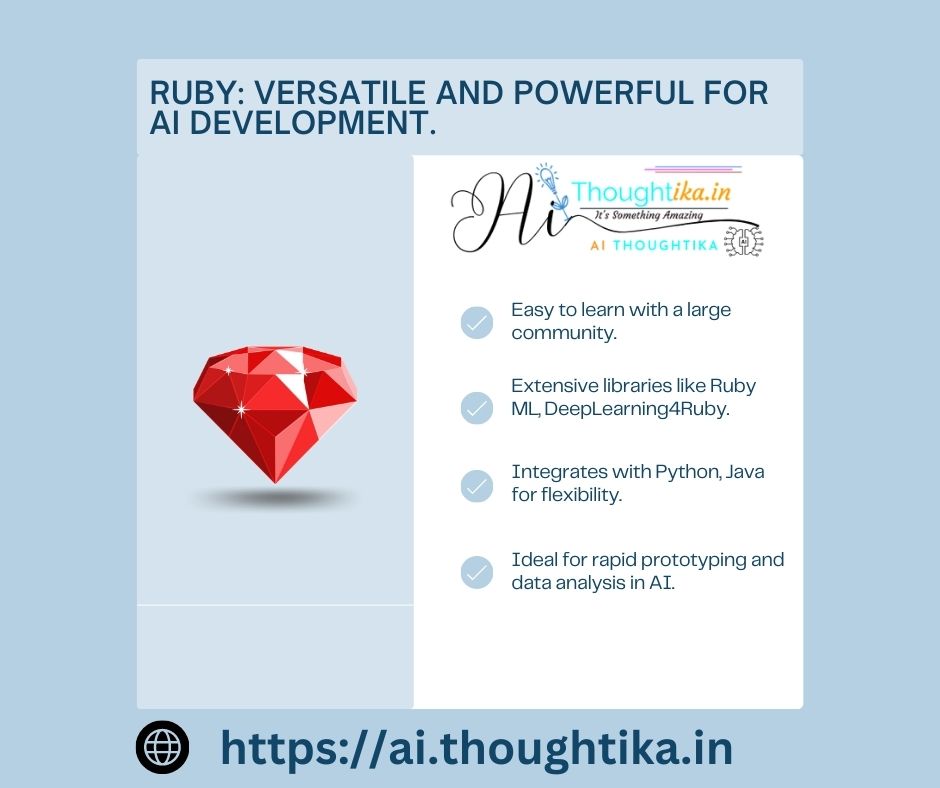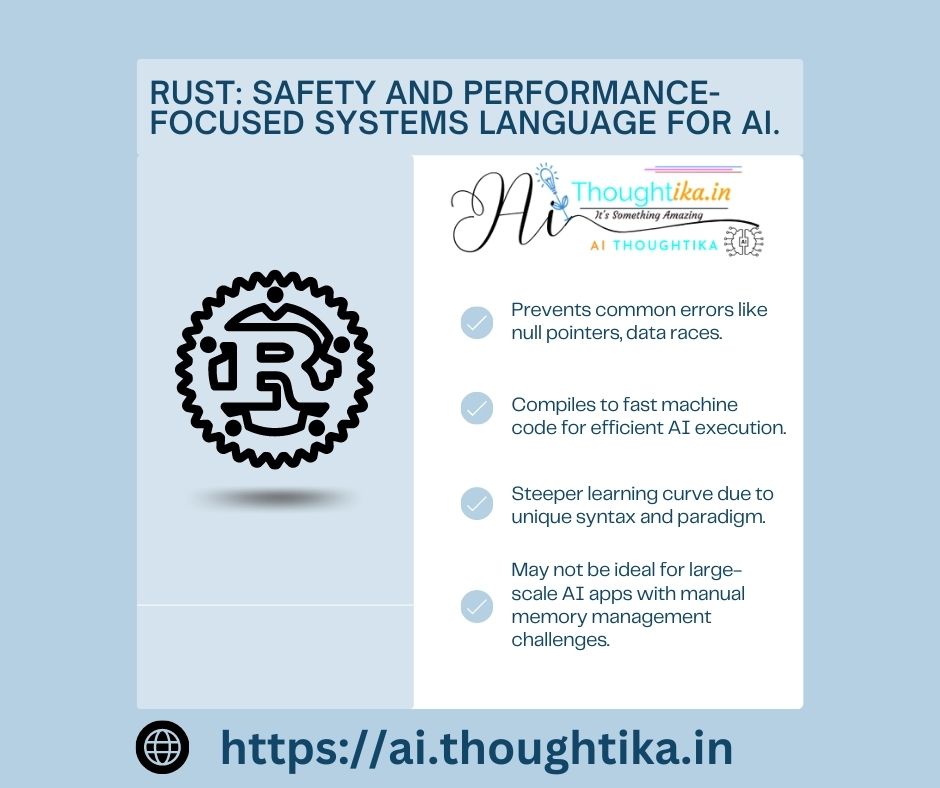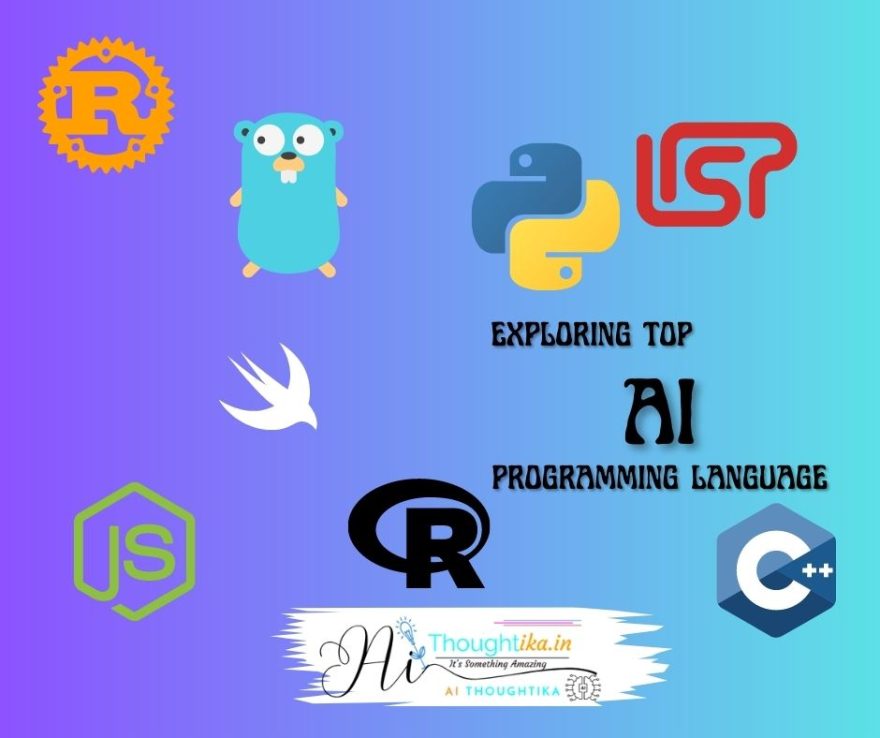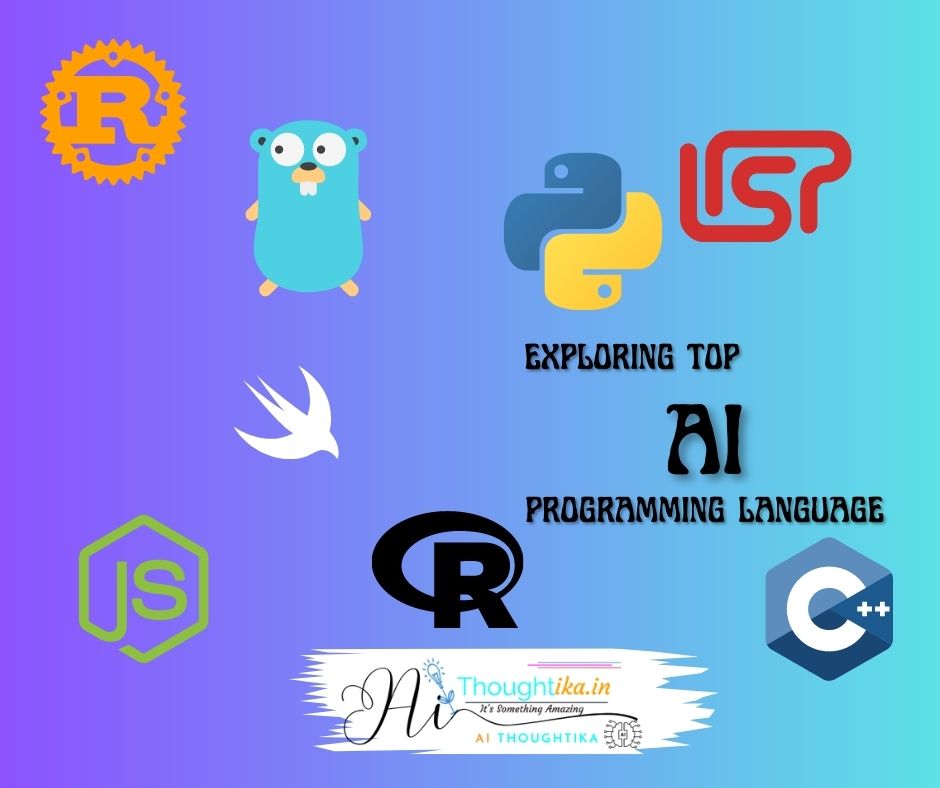Artificial intelligence (AI) changed how we use technology and created opportunities in many industries. AI is essential for modern apps, like self-driving cars and virtual assistants. Top AI programming languages are vital for developing intelligent systems. This article explores these languages and their impact on future AI development.
1. Introduction
AI programming languages give developers the tools they need to create intelligent systems and algorithms that can learn and make decisions based on data. These languages provide a wide range of benefits, from simplicity and efficiency to high performance and scalability. Let’s explore the world of AI programming languages and learn about their distinct capabilities.
2. Python: The Powerhouse of AI
Python has emerged as the powerhouse of AI due to its simplicity, flexibility, and extensive libraries. It has become the most popular language for data science and AI applications, providing an ideal environment for developing machine learning, deep learning, and natural language processing algorithms. Python’s simplicity and ease of use make it an ideal choice for developers who need to quickly prototype and test AI models. Additionally, Python’s extensive libraries, such as NumPy, pandas, and scikit-learn, provide a robust foundation for data manipulation, statistical modeling, and visualization tasks, which are crucial for AI development.

Python’s popularity in AI development is also evident in its use in various industries, including finance, healthcare, and e-commerce. Its ability to handle complex data manipulation, statistical modeling, and visualization tasks makes it an ideal choice for AI applications. With the help of Python libraries like TensorFlow, Keras, and PyTorch, developers can efficiently perform tasks such as data preprocessing, feature engineering, and model evaluation, which are crucial for training and validating AI models. Overall, Python’s simplicity, flexibility, and extensive libraries make it a powerful tool for developers who need to create a wide range of AI applications for diverse industries and use cases.[2]
3. Java: The Versatile Choice
Java has emerged as a versatile choice for AI programming language due to its robust features, platform independence, and extensive libraries. It provides an ideal environment for developing AI applications, including machine learning, deep learning, and natural language processing. Java’s ability to integrate with various databases and technologies makes it a popular choice for developing enterprise-level AI applications. Additionally, Java’s large and active community ensures that there are numerous resources available for developers to learn and stay up-to-date with the latest trends and best practices in AI development.

Java’s versatility in AI development is also evident in its use in various industries, including finance, healthcare, and e-commerce. Its ability to handle complex data manipulation, statistical modeling, and visualization tasks makes it an ideal choice for AI applications. With the help of Java libraries like Weka, Java ML, and Deeplearning4j, developers can efficiently perform tasks such as data preprocessing, feature engineering, and model evaluation, which are crucial for training and validating AI models. Overall, Java’s versatility and flexibility make it a powerful tool for developers who need to create a wide range of AI applications for diverse industries and use cases.
4. R: The Statistical Language for AI
R is a powerful programming language that has gained widespread recognition as a tool for statistical computing and graphics. It has become the de facto standard for data analysis, visualization, and modeling in various fields, including academia, research, and industry. R’s popularity stems from its flexibility, versatility, and extensive range of packages that cater to diverse data analysis needs.

The advent of artificial intelligence (AI) has further reinforced R’s position as a vital tool for data scientists and researchers. R’s ability to handle complex data manipulation, statistical modeling, and visualization tasks makes it an ideal choice for AI applications. With the help of R packages like caret, dplyr, and ggplot2, users can efficiently perform tasks such as data preprocessing, feature engineering, and model evaluation, which are crucial for training and validating AI models. Additionally, R’s seamless integration with other AI tools and languages, such as Python and TensorFlow, makes it an indispensable component of the AI ecosystem.
5. Lisp: The Pioneer of AI
Lisp, or LISt Processing, is a family of programming languages that has been at the forefront of AI development since the 1950s. Lisp’s pioneering role in AI is due to its ability to handle symbolic computation, which is essential for AI applications. Lisp’s unique syntax and semantics make it an ideal choice for representing and manipulating symbolic expressions, which are crucial for AI algorithms. Additionally, Lisp’s extensibility and flexibility have made it a popular choice for developers who need to create custom AI solutions.

Lisp’s influence on AI development is also evident in its use in various industries, including robotics, natural language processing, and computer vision. Lisp’s ability to handle complex symbolic computations makes it an ideal choice for developing AI applications that require manipulation of complex data structures. With the help of Lisp libraries like Common Lisp and Scheme, developers can efficiently perform tasks such as data preprocessing, feature engineering, and model evaluation, which are crucial for training and validating AI models. Overall, Lisp’s pioneering role in AI development has paved the way for the creation of more powerful and sophisticated AI applications.
6. Prolog: The Logic-Based Language
Prolog is a logic-based programming language that has gained popularity in AI development due to its ability to handle complex logical reasoning and rule-based systems. Prolog’s unique syntax and semantics make it an ideal choice for representing and manipulating logical rules, which are crucial for AI applications such as expert systems, natural language processing, and automated reasoning. Additionally, Prolog’s extensibility and flexibility have made it a popular choice for developers who need to create custom AI solutions.

Prolog’s influence on AI development is also evident in its use in various industries, including finance, healthcare, and e-commerce. Prolog’s ability to handle complex logical reasoning makes it an ideal choice for developing AI applications that require logical deduction and rule-based systems. With the help of Prolog libraries like SWI-Prolog and YAP, developers can efficiently perform tasks such as data preprocessing, feature engineering, and model evaluation, which are crucial for training and validating AI models. Overall, Prolog’s logic-based approach to programming has made it a powerful tool for developers who need to create sophisticated AI applications that can handle complex logical reasoning and rule-based systems.
7. Julia: The High-Performance Option
Julia is a high-performance programming language that is gaining popularity in the field of artificial intelligence (AI). It is designed to be fast, efficient, and easy to use. That making it an ideal choice for developers who want to create AI applications quickly and effectively. Julia’s performance is attributed to its just-in-time (JIT) compilation, type system, and other optimizations that allow it to execute code quickly. Additionally, Julia has a number of libraries and tools that make it easy to work with popular AI frameworks and libraries, such as TensorFlow and PyTorch. Overall, Julia is a powerful and flexible language that is well-suited for AI development.[1]

8. JavaScript: AI on the Web
JavaScript is popular for web development and gaining AI traction.
It powers AI web apps, chatbots, and AI integration on web pages.
JavaScript creates AI web scrapers for data extraction and ML tasks.

Various libraries and frameworks in JavaScript support AI development, including TensorFlow.js, Brain.js, and CognitiveJS. These libraries offer pre-built AI models and tools for quick and easy creation of AI-powered web apps.
JavaScript’s capability to manipulate web pages and interact with web APIs makes it an ideal choice for AI-powered web applications. In conclusion, JavaScript’s versatility allows it to cater to a wide range of AI applications on the web.
9. C++: The Robust Performer
C++ is a powerful programming language that is well-suited for AI development due to its performance, control, and flexibility. It provides low-level memory management and control, which can be beneficial for AI applications that require efficient processing and memory usage. Additionally, C++ can be used to develop high-performance AI applications, such as computer vision, machine learning, and deep learning.

C++ can present challenges in AI development as it demands a high level of proficiency and attention to detail. Its steep learning curve and the need for manual memory management can make debugging time-consuming. This aspect might not be the best fit for beginners or those new to AI programming.
Despite its challenges, C++ remains a robust and high-performance language for AI development. It excels in applications that require efficiency and control, making it suitable for various AI tasks. However, when choosing C++ for AI development, project requirements and the developer’s experience level should be carefully considered to ensure a successful and efficient development process.
10. Swift: AI Programming for iOS
Apple developed Swift as a language primarily for iOS, macOS, watchOS, and tvOS apps. Although it supports AI development, it might not be the optimal option for AI programming on iOS devices.
Swift allows developers to create powerful, modern apps with a clean, easy-to-read syntax. However, its AI capabilities are limited compared to Python, Java, or C++. SwiftAI, its AI library, is in early stages and lacks the maturity of other AI libraries.
Therefore, while Swift can develop AI apps on iOS, it may not be ideal for complex AI tasks. When deciding on Swift for AI development, consider project needs, goals, and the developer’s expertise.
11. Ruby: The Dynamic Scripting Language
Ruby is a versatile and powerful language for AI development. It’s easy to learn, flexible, and has a large community. Ruby has extensive libraries for AI development, such as Ruby ML and DeepLearning4Ruby. It can be integrated with other languages, such as Python and Java.

Ruby is ideal for rapid prototyping and experimentation. Ruby’s syntax and nature make it ideal for data analysis and machine learning. It’s a dynamic language, which means that it can be used for a wide range of AI applications. Ruby has a number of libraries and frameworks that can be used for AI development. It’s a great choice for beginners or those who want to quickly prototype AI ideas. Ruby is a robust language that can be used for a wide range of AI development projects.
12. Go: Simplicity and Efficiency for AI
Go (Golang) is an excellent language for AI due to simplicity, efficiency, and performance. It’s modern, user-friendly, and versatile for various applications, including AI development.
One primary advantage of Go for AI is its ease of use. Its simple syntax is easy to read and write, allowing developers to focus on AI algorithm logic rather than complex syntax. Moreover, its simplicity fosters easier collaboration among developers on AI projects.

Go offers the advantage of efficiency in AI development. It’s a high-performance language, ideal for creating high-performance AI apps. Go’s efficiency arises from its direct compilation to machine code, resulting in faster execution compared to languages needing a virtual machine or interpreter.
13. Scala: The Scalable AI Language
Scala’s type system and object-oriented design make it a great choice for building scalable AI systems. The type system helps catch errors early in development, and the object-oriented design. Which makes it easy to organize and structure code in a modular way.
Scala also has a number of libraries and frameworks that are specifically designed for AI development. For example, the ScalaNLP library provides a set of natural language processing tools. The ScalaML library provides tools for machine learning.

Additionally, the Apache Spark project, which is written in Scala, provides a powerful framework for building scalable machine learning models. Spark allows developers to process large amounts of data in parallel. This making it well-suited for training machine learning models on large datasets.
Overall, Scala’s combination of strong type checking, object-oriented design. Along side large community of developers make it a great choice for building scalable AI systems.
14. Rust: Safety and AI Development
Rust is a systems programming language that prioritizes safety and performance. While it can be used for AI development, it may not be the best choice for every AI project.
Rust’s focus on safety and performance can be beneficial for AI development. Because it can help prevent common programming errors like null pointer dereferences and data races. Additionally, Rust’s ability to compile to machine code directly can result in faster execution times compared to other languages. That is plus point over other languages require a virtual machine or interpreter.

However, Rust may not be the best choice for every AI project. Rust’s syntax and programming paradigm can be unfamiliar to developers who are used to other languages, which can result in a steeper learning curve. Additionally, Rust’s lack of a garbage collector can make manual memory management more difficult, which may not be ideal for large-scale AI applications that require a lot of memory.
Ultimately, whether or not Rust is a good choice for AI development depends on the specific needs and goals of the project. If safety and performance are top priorities, and the development team is familiar with Rust’s syntax and programming paradigm, then Rust may be a good choice. However, if the project requires a more flexible syntax or easier memory management, then another language may be more suitable.[3]
15. Conclusion
AI programming languages drive the AI revolution. Each has unique strengths for diverse AI development needs. Python’s simplicity, Java’s versatility, R’s statistics, Lisp’s history, and Prolog’s logic all contribute to AI progress. As AI evolves, languages will enable thrilling future possibilities.
16. FAQs
Q1: Is Python the best language for AI development?
Python is widely considered one of the best languages for AI development due to its simplicity, extensive library support, and a large community of developers.
Q2: Can I use JavaScript for AI projects?
Yes, with the advent of libraries like TensorFlow.js, JavaScript has become a viable option for AI development, particularly for web-based AI applications.
Q3: Which language is suitable for real-time AI systems?
C++ is an excellent choice for real-time AI systems due to its efficiency and low-level control over hardware resources.
Q4: Is AI programming limited to certain industries?
No, AI has applications across various industries, including healthcare, finance, gaming, robotics, and more.
Q5: What is the future of AI programming languages?
The future of AI programming languages is promising, with a continued focus on improving performance, scalability, and ease of use to support the ever-growing AI landscape.





